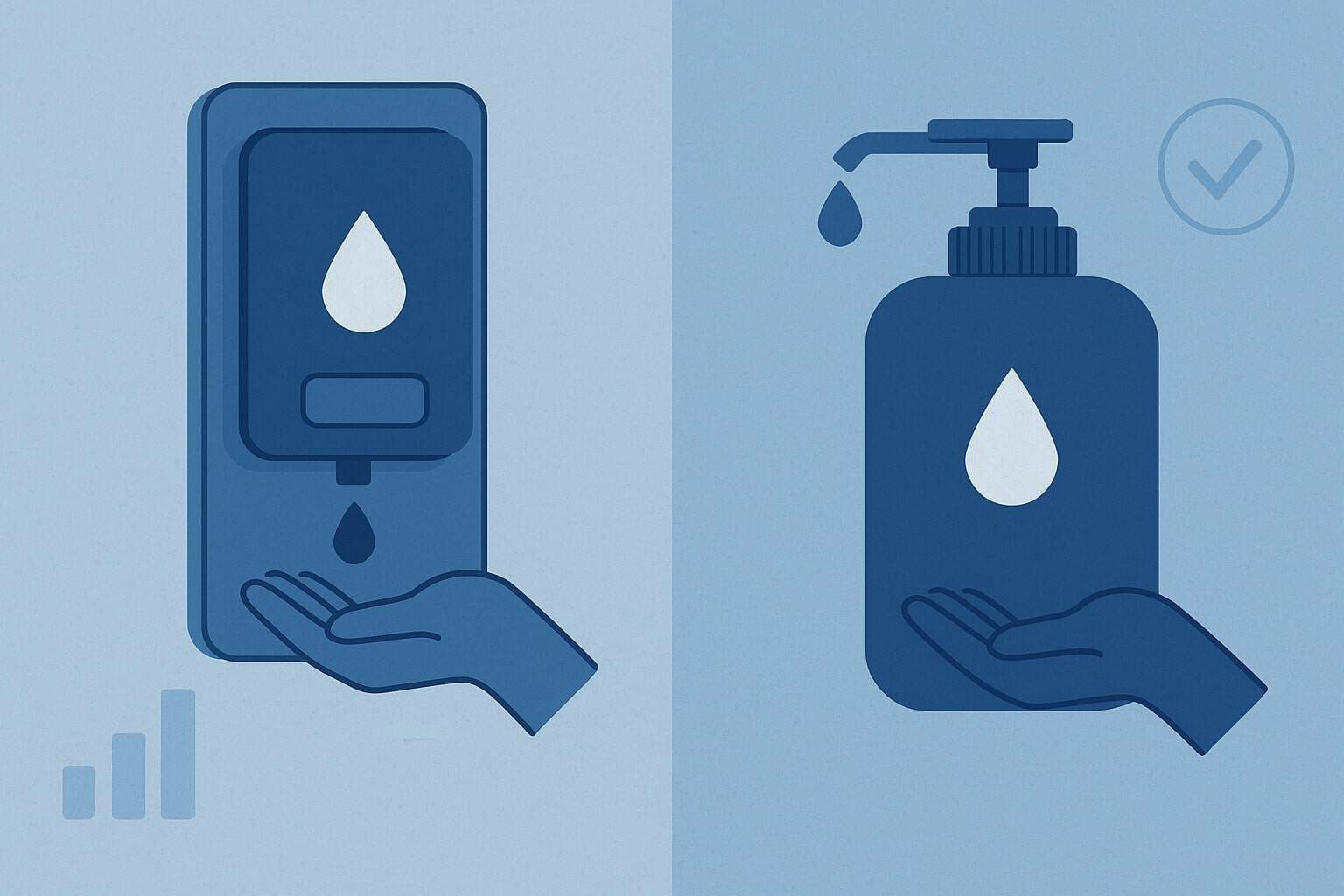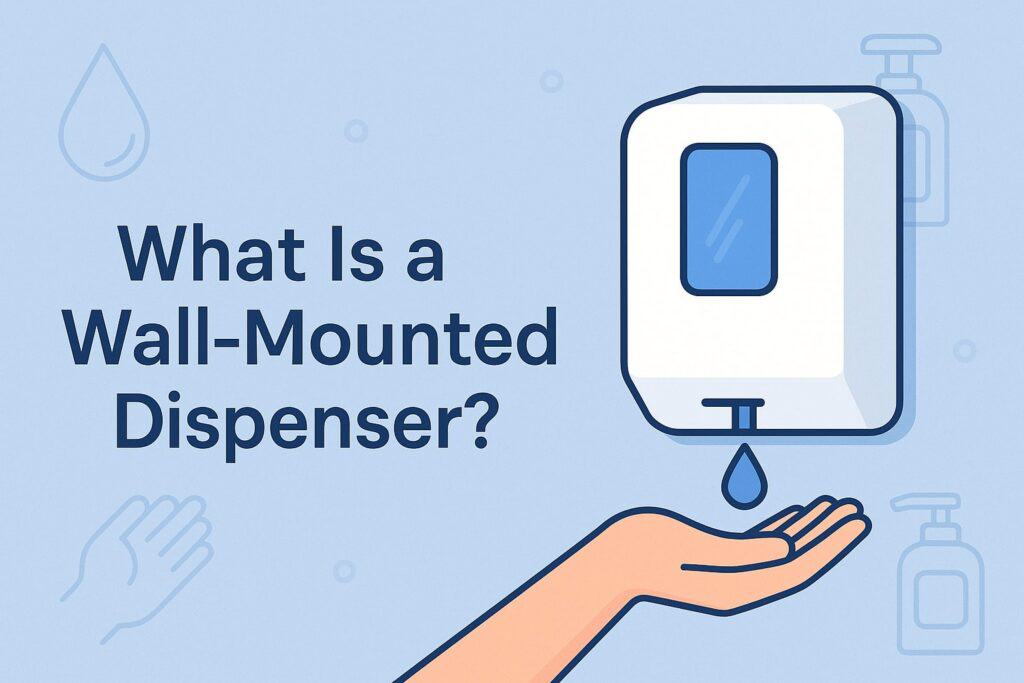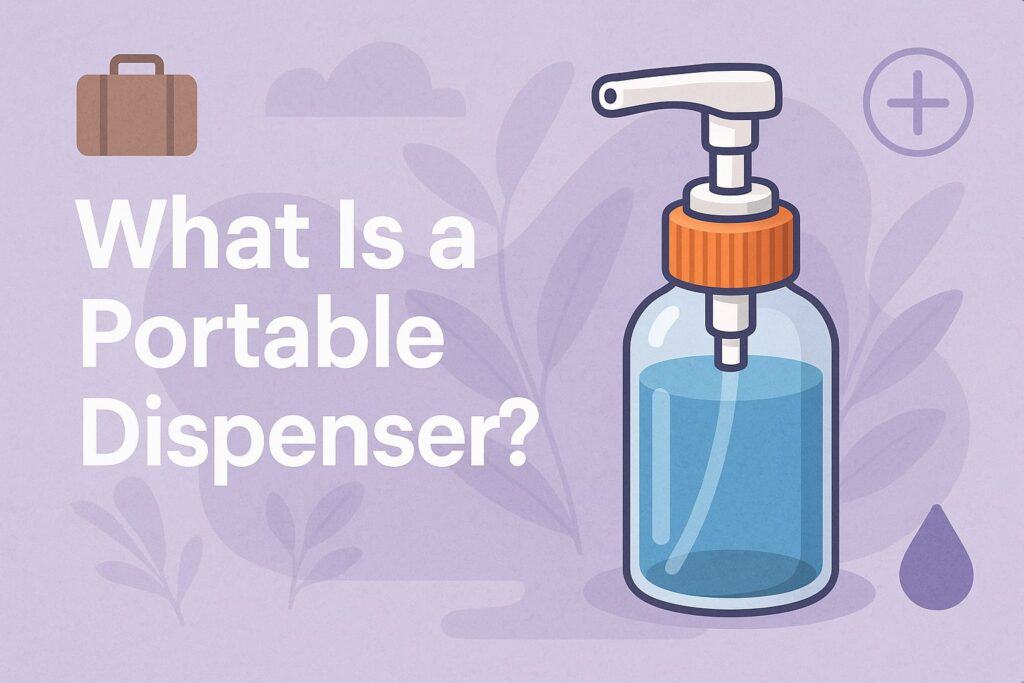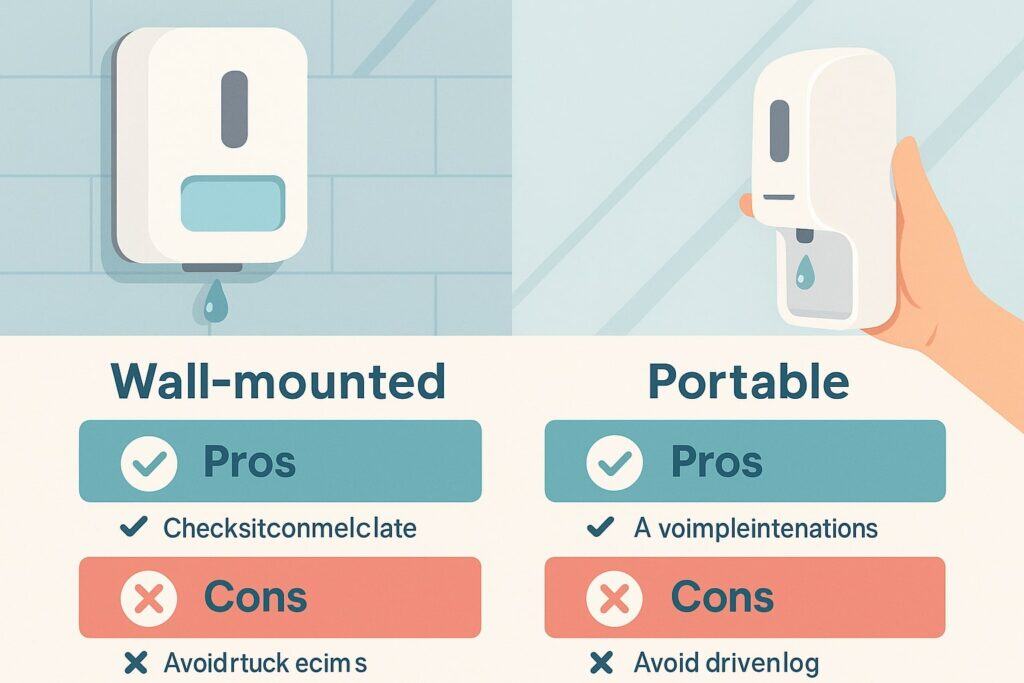
By myhandsanitizershop October 16, 2025
Choosing between wall-mounted dispensers and portable dispensers sounds simple—until you factor in hygiene standards, traffic patterns, ADA accessibility, long-term costs, and the real-world way people use restrooms, classrooms, lobbies, and job sites across the U.S.
This guide breaks down wall-mounted vs. portable dispensers in clear, practical terms so you can match the right format to your space, budget, and compliance needs.
You’ll learn how each dispenser type fits different environments, the pros and cons that actually matter, the technology options that reduce waste, and the total cost of ownership you should expect over the product’s life.
Whether you’re outfitting a single storefront or standardizing across multiple locations, this “latest and updated” overview will help you decide quickly and confidently.
What Is a Wall-Mounted Dispenser?

A wall-mounted dispenser is a fixed unit secured to a vertical surface, partition, or stand-alone mounting plate. These are common for soap, sanitizer, paper towels, toilet tissue, air freshener cartridges, and even multi-feed hand care systems.
In the wall-mounted vs. portable dispensers decision, the biggest appeal of wall-mounted dispensers is consistency: you place the unit once at an optimal height, connect it to your standard refill program, and enjoy predictable usage and traffic flow.
Because they live in a single spot, wall-mounted dispensers help users form habits—enter, dispense, and move on—reducing bottlenecks and encouraging better hygiene compliance.
From a facilities perspective, wall-mounted dispensers shine in high-traffic or mission-critical areas where you cannot afford empty units or roaming bottles. They’re usually lockable, which protects refills from pilferage and keeps the system secure.
Many modern wall-mounted dispensers are touchless (infrared or proximity sensors), minimizing cross-contamination and helping you meet internal hygiene protocols.
Durable housings—often ABS plastic, stainless steel, or powder-coated metal—stand up to frequent cleanings with the U.S.-approved disinfectants and won’t degrade in damp restrooms or food-prep zones.
Importantly, fixed units also enable usage analytics with smart IoT modules that monitor fill levels and service alerts, tightening your labor schedule and cutting last-minute emergencies.
In the U.S., a key advantage of wall-mounted dispensers is support for ADA reach ranges when installed correctly (for example, locating controls within reach and ensuring clear floor space).
While you should always verify location-specific codes and manufacturer instructions, being able to consistently mount at the right height is a major win for accessibility.
What Is a Portable Dispenser?

Portable dispensers include countertop pumps, freestanding floor stands, clip-on or magnetic units, and lightweight caddies. They excel when mobility matters: events, pop-up retail, seasonal traffic spikes, trade shows, construction and outdoor venues, or anywhere you can’t drill and mount hardware.
In the wall-mounted vs. portable dispensers debate, portability equals flexibility. You can move units as foot traffic shifts, add capacity during cold and flu season, or redeploy dispensers to a lobby during a marketing activation—no tools required.
Portable dispensers range from simple pump bottles to sleek, battery-powered, touchless towers with weighted bases. Many accept bulk refills to reduce per-use costs and plastic waste, and some incorporate drip trays to minimize mess on floors or tabletops.
For schools, camps, farmers markets, and mobile medical or vaccination sites, portable dispensers are often the only feasible option—no walls, no problem. They also help during renovations when permanent fixtures are temporarily out of service.
Because they’re visible and easy to position near entrances or checkpoints, portable dispensers can boost hand hygiene compliance at the exact moment of need.
However, portability introduces new responsibilities. Units can migrate, get knocked over, or walk away without a tethered location. Refill tracking is less predictable, and batteries (for touchless models) require a maintenance cadence.
Portable stands must be sturdy enough to avoid tip hazards and placed to reduce obstruction risks. If your facilities team can handle these variables, portable dispensers make a compelling case in the wall-mounted vs. portable dispensers comparison—especially for dynamic spaces and seasonal or multi-use environments.
Pros and Cons at a Glance (and What They Mean in Practice)

When you compare wall-mounted vs. portable dispensers, focus on how the pros and cons play out in your day-to-day operations. Wall-mounted dispensers offer permanence, security, and standardized placement; portable dispensers deliver agility, rapid deployment, and low installation complexity.
Wall-mounted units tend to win for high-traffic restrooms and back-of-house areas because they can be locked, metered, and serviced on a predictable route. Portable units often win for entrances, lobbies, events, and transitional spaces.
Wall-Mounted Dispensers
Pros: durable, lockable, touchless options, ADA-friendly placement, consistent user flow, optional IoT monitoring, reduced pilferage, streamlined refilling.
Cons: require drilling or adhesive mounting, initial install planning, less flexible once placed, relocation holes may need patching.
Portable Dispensers
Pros: mobile, easy to deploy, great for temporary or seasonal needs, low barrier to start, no drilling, excellent for outreach or construction.
Cons: more vulnerable to movement and theft, can tip if not weighted, refill tracking is less standardized, batteries to manage on touchless models.
The right answer to wall-mounted vs. portable dispensers depends on your risk tolerance and operating rhythm. If you prioritize tight inventory control and minimal visual clutter, wall-mounted is strong.
If you prioritize flexibility and quick reconfiguration, portable shines. Many U.S. facilities ultimately adopt a hybrid strategy: wall-mounted in restrooms and kitchens, portable at entrances, conference areas, and pop-up zones.
Hygiene, Safety, and Compliance (U.S. Considerations)
A central reason the wall-mounted vs. portable dispensers choice matters is hygiene. Placement determines whether people actually sanitize or wash. In restrooms and food-handling zones, fixed, touchless wall-mounted dispensers with proper mounting height help standardize compliance.
In entryways and high-visibility points, portable stands “nudge” users when they first arrive. For U.S. operators, always align with your internal policies and applicable guidelines from authorities having jurisdiction (AHJs).
While details vary by state, aim for dispensers that support thorough hand hygiene, minimize cross-touch, and are easy to clean.
Accessibility is essential. Consider clear floor space, protrusion limits, and reachable controls when installing wall-mounted units. Portable dispensers need careful placement to avoid blocking pathways and to ensure stable access for wheelchair users.
In schools, healthcare, and food service, select materials that withstand frequent disinfection and verify chemical compatibility (e.g., alcohol-based sanitizers vs. plastics) to prevent crazing or leaks.
Safety also includes fire considerations: large-volume alcohol-based sanitizer must be stored and placed responsibly. Many wall-mounted systems use sealed cartridges that reduce spill risks, while portable bulk systems need drip trays and steady bases.
Regardless of where you land on wall-mounted vs. portable dispensers, formalize a cleaning and inspection routine that includes housing integrity, pump function, sensor responsiveness, drip management, and correct product labeling.
Installation and Placement Best Practices
Successful installation begins with a site walk. Map traffic patterns, observe door swings, and note existing fixtures before deciding wall-mounted vs. portable dispensers.
For wall-mounted units, verify substrate type (tile, drywall with backing, stainless, partition) and choose proper anchors or manufacturer-approved adhesive plates.
Confirm heights that support universal access and consistent ergonomics, and avoid locations that invite splashes or block sightlines. Use mounting templates, pilot holes, and a small bubble level to keep lines clean and professional.
For portable dispensers, select bases with sufficient weight and low center of gravity. Position freestanding units just off the main path—close enough to encourage use, but far enough to reduce collisions.
If you use countertop dispensers, add non-slip mats and drip trays. For both types, finalize a visible refill schedule and label the product (soap or sanitizer type, active ingredient, and expiration if applicable). Clear labels reduce confusion and improve user trust.
Finally, consider power needs. Many touchless wall-mounted dispensers run on batteries; some offer AC adapters. Portable touchless units rely on batteries; standardize battery sizes across your fleet to simplify inventory.
Good installation and placement transform the everyday experience and often settle the wall-mounted vs. portable dispensers decision in favor of the format that fits your physical reality.
Refill Options, Compatibility, and Waste Reduction
Refill strategy is where costs spiral—or shrink. Cartridge systems in wall-mounted dispensers deliver consistent dosing, cleaner changeovers, and often better hygiene due to sealed packaging.
Bulk-fill reservoirs (common in portable units and some wall-mounted models) are cheaper per ounce but risk contamination if not handled carefully.
In the wall-mounted vs. portable dispensers conversation, ask vendors about dose size (e.g., 0.8–1.2 mL per activation for sanitizer), viscosity range (foam vs. liquid), and compatible formulations (alcohol-based, benzalkonium chloride, fragrance-free, or moisturizing soaps).
To reduce waste, consider metered dosing and foam formats that provide effective coverage with less product. Lockable housings deter tampering and theft.
For U.S. sustainability goals, look for post-consumer recycled (PCR) plastics, recyclable refill cartridges, and bulk packaging that cuts transport emissions. In healthcare, verify compatibility with commonly used disinfectants to prolong housing life.
If you’re piloting smart dispensers, link usage data to janitorial routes—service the right dispenser at the right time. These factors often make wall-mounted systems the efficiency leaders, but portable dispensers can compete when standardized with bulk refilling protocols and trained staff.
Durability, Design, and Aesthetics
Durability protects your investment. Wall-mounted dispensers built from ABS, stainless, or aluminum resist impacts, harsh cleaning, and humidity. Portable dispensers need rigid columns, weighted bases, and sturdy housings to survive movement and crowd interactions.
In high-end lobbies and hospitality, design cues matter: slim profiles, matte finishes, and concealed locks look clean and intentional. In the wall-mounted vs. portable dispensers equation, aesthetics can tip the scale, especially where brand experience is part of the value proposition.
Don’t overlook serviceability. Quick-open doors, visible fill windows, and tool-less cartridge swaps reduce downtime. Choose models with readily available parts (no obscure batteries, seals, or proprietary screws).
Standardize finishes and footprints across your portfolio to simplify replacements. If visual cohesion is your priority, many manufacturers offer coordinated families (soap, sanitizer, and paper) in the same style, letting you mix wall-mounted and portable dispensers while keeping a unified look.
Technology Features: Touchless, Smart Sensors, and IoT
Touchless operation is now the baseline in many U.S. sectors. Infrared sensors limit cross-touch, and adjustable dose settings tailor cost vs. efficacy. Some dispensers—more often wall-mounted—offer IoT modules that transmit fill levels, battery status, and usage counts to a dashboard.
This data lets you set service thresholds, predict peak times, and optimize labor. In the wall-mounted vs. portable dispensers comparison, wall-mounted units usually lead for smart features because they’re fixed and easier to track, but newer portable towers also support Bluetooth or cellular modules.
When you evaluate smart options, scrutinize battery life under real conditions, encryption and data ownership, and how the platform integrates with your existing workflows. Look for “offline fallback” so dispensers still operate during connectivity hiccups.
If you run multi-site operations, remote visibility smooths central planning and ensures brand-level consistency. Smart tech won’t make a poor placement perfect, but it can turn a good wall-mounted vs. portable dispensers strategy into an efficient, measurable program.
Total Cost of Ownership (TCO): Beyond the Sticker Price
Initial price tags can mislead. TCO blends acquisition cost, installation time, refill price per ounce, dose consistency, labor to service, battery usage, replacement parts, and shrinkage (loss/theft).
Wall-mounted dispensers involve mounting labor but often repay through controlled dosing, lower pilferage, and faster service routes. Portable dispensers save on installation but can generate hidden costs if units go missing, tip over, or require frequent battery swaps.
In the wall-mounted vs. portable dispensers decision, run a 12–36 month model with realistic assumptions for traffic, dose size, and refill frequency.
Here’s a simple approach: estimate daily activations per location, multiply by dose volume to get ounces per day, then price refills accordingly. Add labor minutes for refilling (cartridges are typically quicker than bulk pours), plus inspection time and battery costs.
If you plan to scale, ask vendors for volume pricing and replacement part costs. Many U.S. operators discover that a hybrid rollout—wall-mounted in stable zones, portable for surge capacity—delivers the best TCO and performance across seasons.
Where Each Format Works Best (Use-Case Scenarios)
- Healthcare and Schools: Wall-mounted dispensers at every restroom, classroom sink, and near high-risk zones standardize hygiene and support accessibility.
Portable stands at entrances, cafeterias, assemblies, and nurse’s offices create high-visibility prompts. In wall-mounted vs. portable dispensers, this hybrid is a proven playbook. - Retail and Hospitality: Wall-mounted in restrooms and breakrooms; portable at store entrances, hostess stands, conference rooms, and event spaces. Seasonal spikes (holidays, flu season) are easier to handle with extra portable towers.
- Food Service and Manufacturing: Wall-mounted for handwashing near prep lines and production entries (with clear signage), backed by portable dispensers at receiving docks, time clocks, and QC checkpoints. Consistency plus coverage wins the wall-mounted vs. portable dispensers matchup.
- Events, Pop-Ups, and Construction: Portable dominates. Use weighted bases, clear labels, and a route for battery checks and bulk refills. If a site becomes permanent, convert high-use zones to wall-mounted units for long-term efficiency.
Sustainability and Environmental Impact
Sustainability can be a tie-breaker in wall-mounted vs. portable dispensers. Cartridge systems minimize contamination and product waste, and many vendors now offer recyclable or PCR-content packaging.
Bulk-fill portable programs reduce single-use plastics but demand clean handling to avoid microbial growth. Evaluate cradle-to-grave factors: material durability, refill transportation footprint, and whether the vendor offers take-back or recycling options.
Dose control is sustainability gold—less over-dispensing means fewer shipments, lower costs, and reduced waste.
Energy-wise, choose efficient sensors and long-life batteries, and consolidate SKUs to prevent partial, expired inventories. If you renovate, preserve mounting locations that work; reusing infrastructure is a quiet sustainability win.
When paired with user education and signage, both wall-mounted and portable dispensers can hit U.S. sustainability targets without compromising hygiene.
Buying Checklist: Questions to Ask Vendors
Before you finalize wall-mounted vs. portable dispensers, press your supplier for specifics. Confirm refill pricing tiers, dose adjustability, compatibility with your preferred formulations, housing materials, locking mechanisms, and availability of spare parts.
Ask for installation templates, recommended mounting heights, and guidance for ADA-friendly placement. If you’re exploring smart options, request a demo of the dashboard, battery-life data, over-the-air update policies, and escalation pathways for hardware failures.
Inquire about warranty terms, lead times, and multi-site rollout support across the U.S. Look for sample units to test with your staff. Finally, discuss sustainability claims: PCR content documentation, recyclability, and any packaging take-back programs.
A structured checklist turns the wall-mounted vs. portable dispensers conversation into a concrete, apples-to-apples evaluation.
Decision Framework: How to Choose Quickly (and Confidently)
Use this fast framework to resolve wall-mounted vs. portable dispensers in minutes:
- Map spaces: Restrooms, kitchens, entries, conference rooms, outdoor or temporary areas.
- Traffic & risk: High, medium, low. If high and permanent, lean wall-mounted. If variable or temporary, lean portable.
- Compliance & access: Can you mount at accessible heights with clear floor space? If not, choose stable, portable stands placed thoughtfully.
- Service model: Route-based, data-driven? Wall-mounted with cartridges and/or IoT might fit best. Ad hoc and event-driven? Portable bulk systems may win.
- TCO reality: Model 12–36 months. Include labor, batteries, refills, shrinkage, and parts.
- Aesthetics & brand: Do you need a unified look? Choose a coordinated family that offers both wall-mounted and portable formats.
- Sustainability: Favor dose control, recyclable packaging, and durable housings.
Most U.S. organizations land on a hybrid approach: wall-mounted dispensers where people always need them and portable dispensers where patterns change. That balance captures consistency, flexibility, and cost control.
FAQs
Q.1: Are wall-mounted dispensers more hygienic than portable dispensers?
Answer: Both can be highly hygienic when used and maintained properly. Touchless sensors, correct placement, and consistent refilling matter more than format.
Wall-mounted units reduce wandering bottles and promote predictable use, while portable dispensers meet users at the point of need.
In the wall-mounted vs. portable dispensers debate, hygiene performance is a function of product quality, dose control, and service discipline—not just mounting style.
Q.2: What’s the best option for ADA accessibility?
Answer: Either can meet accessibility goals if positioned correctly. Wall-mounted units allow precise, repeatable mounting heights and control locations; portable units must be placed to ensure stable access and clear approach space.
In wall-mounted vs. portable dispensers, choose the format that lets you consistently meet reach ranges and maintain clear pathways at your site.
Q.3: Which format costs less over time?
Answer: It depends on traffic, dose size, refill price, labor, and shrinkage. Wall-mounted systems often win TCO in permanent, high-use zones because they control dosing and reduce movement and loss.
Portable dispensers minimize installation costs and excel for temporary or seasonal needs. A blended strategy often unlocks the best long-term value in the wall-mounted vs. portable dispensers choice.
Q.5: Are smart (IoT) dispensers worth it?
Answer: If you manage multiple sites or high-traffic venues, yes—usage analytics reduce emergency calls, optimize routes, and cut waste. Wall-mounted units lead here, but some portable towers support sensors too.
In wall-mounted vs. portable dispensers, smart features amplify whichever layout you choose by aligning service to real demand.
Q.6: Can I use bulk refills with both formats?
Answer: Many wall-mounted and portable dispensers support bulk refills; others use sealed cartridges. Bulk can lower cost and plastic waste but needs disciplined handling to prevent contamination.
Cartridges offer clean swaps and consistent dosing. The wall-mounted vs. portable dispensers question becomes: do you value per-ounce savings or speed and hygiene simplicity?
Conclusion
There is no one-size-fits-all winner in wall-mounted vs. portable dispensers—and that’s good news. Wall-mounted dispensers deliver durable, secure, and compliant placement for restrooms, kitchens, and other fixed zones. Portable dispensers deliver rapid deployment, flexibility, and targeted coverage where traffic ebbs and flows.
When you evaluate your footprint, traffic patterns, accessibility needs, and service model, a practical answer emerges—often a hybrid: wall-mounted for the routines that never change, portable for everything that does.
Keep your decision anchored in the realities of your U.S. locations: how people move, how teams service, and how refills flow. Prioritize touchless operation, dose control, durable materials, and clear labeling. Model the total cost, not just the sticker price.
If you combine smart placement with reliable products and consistent maintenance, you’ll get higher hygiene compliance, a cleaner guest experience, and lower lifetime costs—no matter how you balance wall-mounted vs. portable dispensers across your spaces.